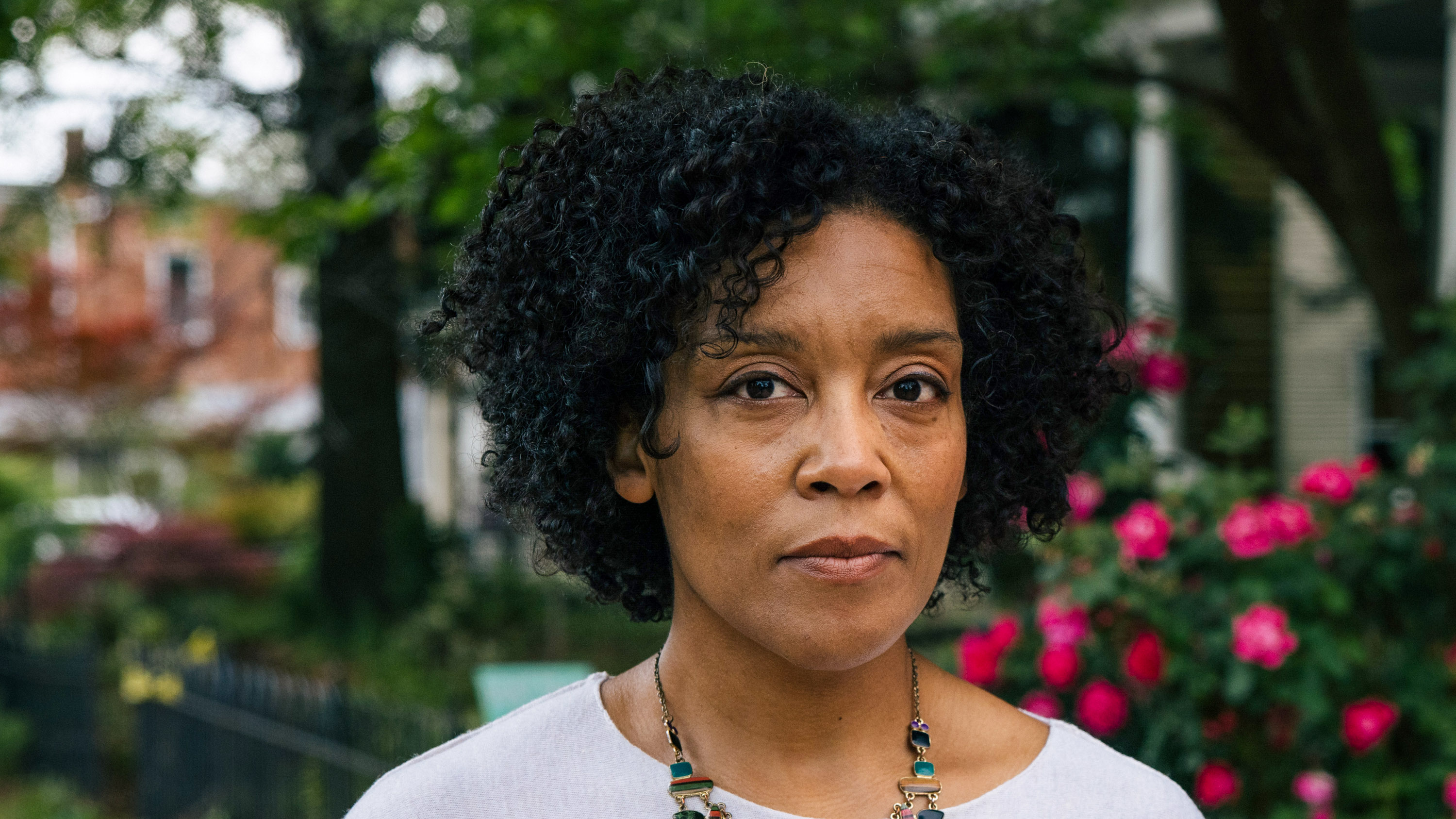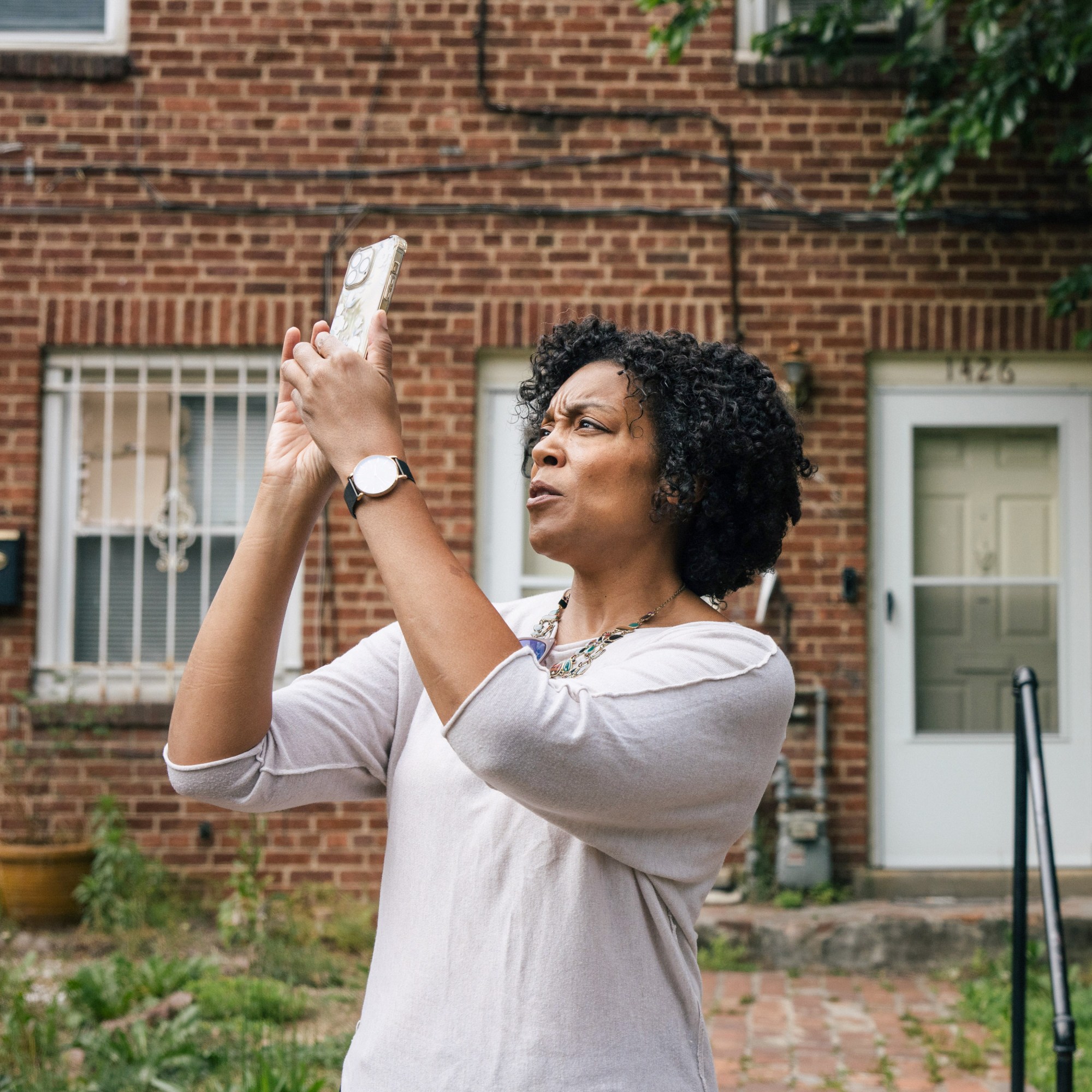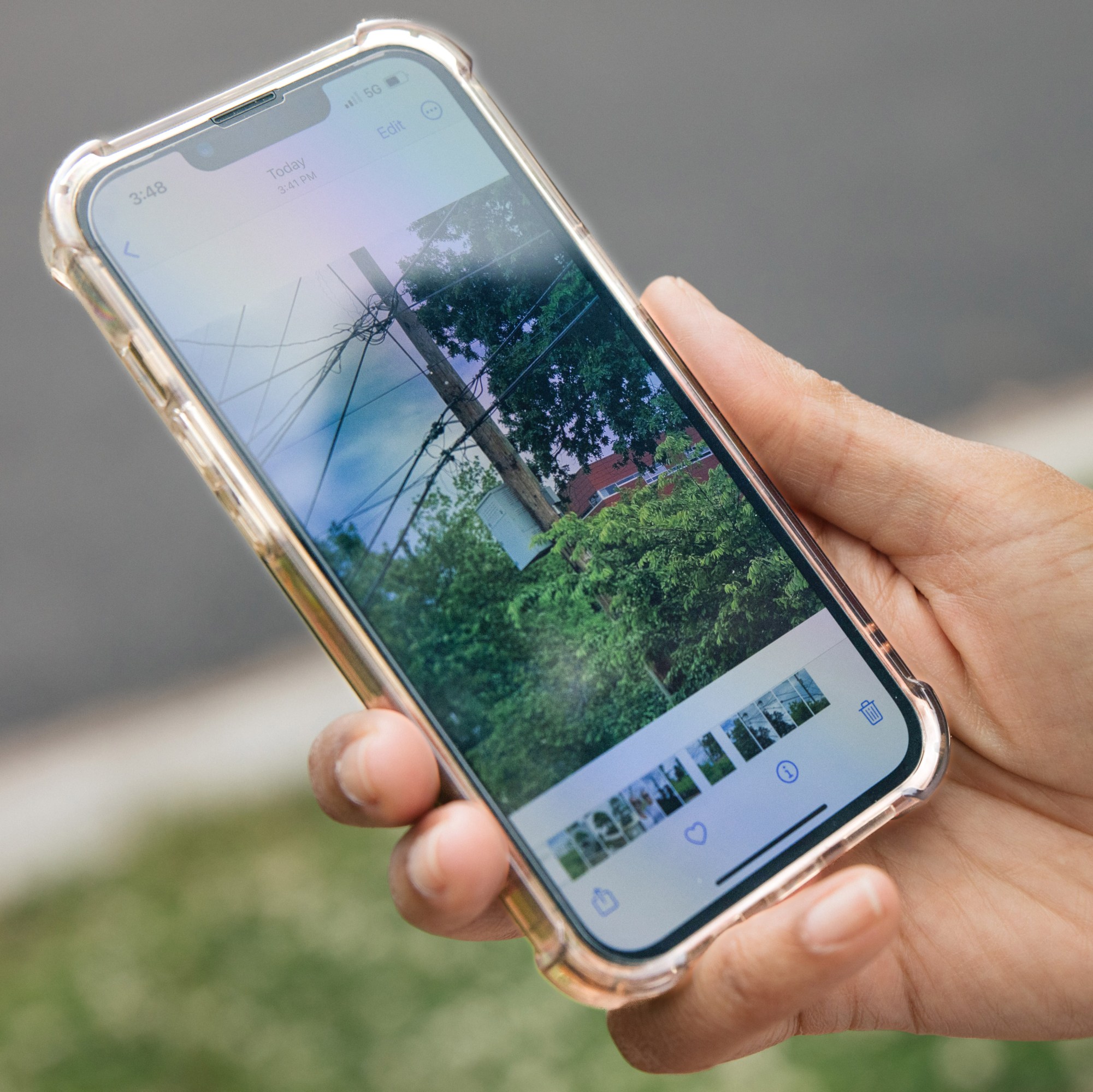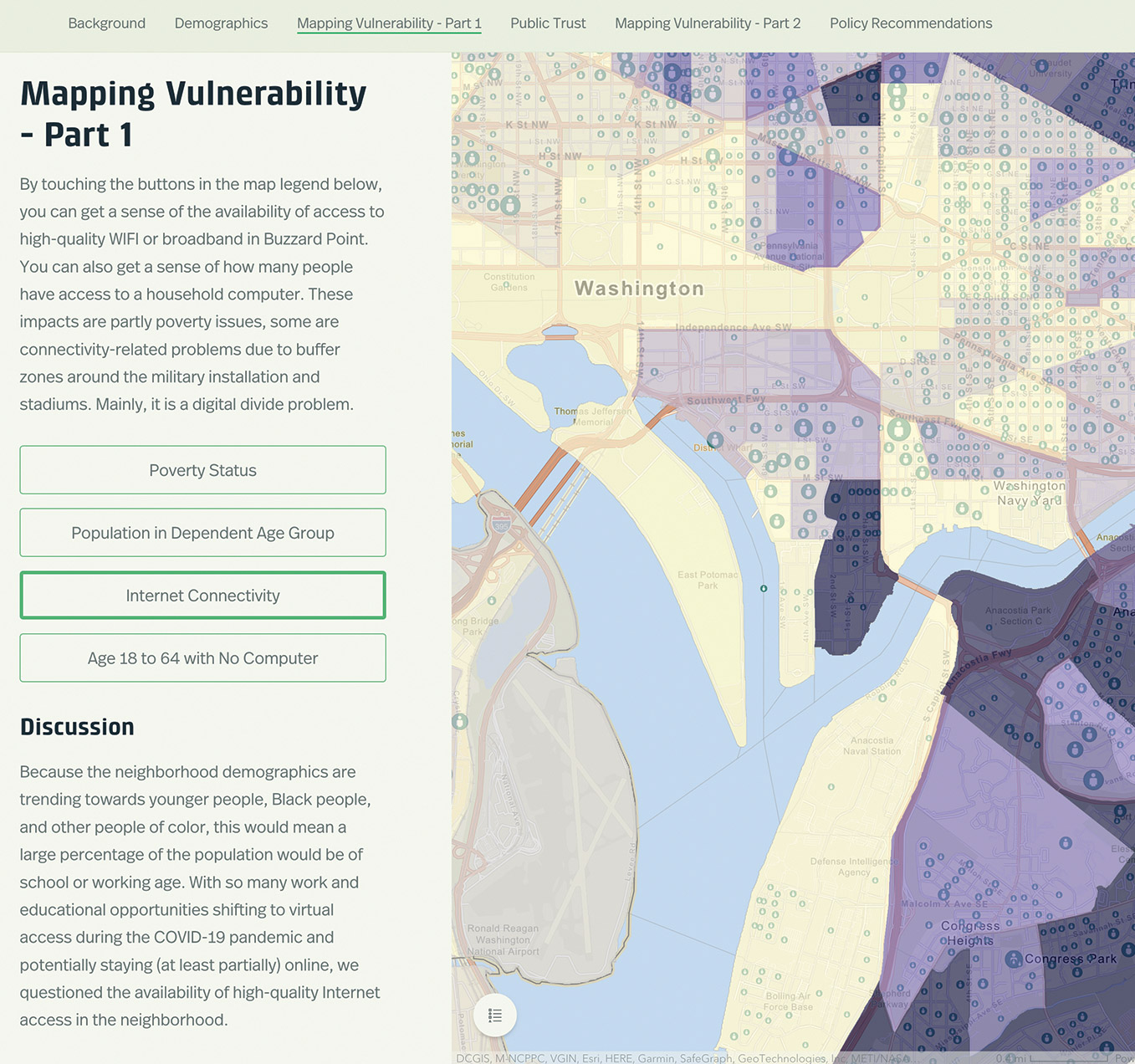How climate vulnerability and the digital divide are linked
Monica Sanders’s Undivide Project is documenting overlapping issues in underserved communities in the US.

The Wi-Fi signal is weak outside the Frederick Douglass National Historic Site in Anacostia, a historic African-American section of Washington, DC. The abolitionist leader’s former home sits serenely atop a grassy hill in the otherwise bustling neighborhood. It is one of Monica Sanders’s final stops on an overcast December afternoon. Facing the property, she holds her iPhone out to measure Wi-Fi speeds. The readings flutter between single and double digits before settling on a final result: 10.8 megabits per second (Mbps) download and 8.23 Mbps upload. Much faster than dial-up, to be sure. But these speeds fail to meet the Federal Communications Commission’s minimum to qualify as broadband service, despite the multiple free municipal Wi-Fi access spots in the area.
Sanders, an adjunct professor of law at Georgetown University, isn’t just checking Wi-Fi speeds. She’s drawing connections between a host of indicators at the intersection of internet availability, environmental risk, and historical racial inequity. The findings will be added to a report that Sanders and her colleagues are assembling for the Undivide Project, a nonprofit she launched in 2022. The organization conducts research pro bono for communities to help them document evidence of the digital divide—the gap between areas with and without adequate internet access—as well as the root causes and linked effects of this discrepancy.
So far, her findings in Anacostia fit a pattern Sanders has noticed walking around low-income majority-minority neighborhoods throughout the US: a lack of internet access mirrors other inequities. In neighborhoods shaped by racism and insufficient infrastructure investment, among other structural choices, residents can face disproportionate risk from climate change, affecting everything from flood vulnerability to the ability to get disaster warnings.
This is what researchers call “cascading risks,” she says. “How do we understand what’s going on with internet speeds?” What are “the legal and social as well as geographical reasons why there’s no coverage in some places?”
After she records the Wi-Fi numbers, she checks the temperature: 46.9 °F. Then, as she did at a series of sites earlier that day—outside the Anacostia train station, a local charter school, and an under-construction hospital, to name a few—she lifts her cell phone and snaps a photo of the scene to help with the record-keeping.
Exclusionary practices like redlining, which long restricted access to loans and suppressed home values in many majority-minority neighborhoods, have created generational inequity throughout the United States. Though redlining was banned decades ago, these areas are still more likely to be economically depressed, and their public services are more likely to be underfunded. Sanders believes the digital divide is another artifact of these policies. So are the additional difficulties communities may face in weathering the threats posed by extreme heat, flooding, and other hazards intensified by climate change.
Studies from the Pew Research Center, the most recent conducted in 2021, have repeatedly found that Black and Hispanic adults in the United States are less likely than white adults to have broadband access at home. Researchers have also linked the legacy of redlining to heightened flood risks and higher temperatures due in part to a lack of investment in infrastructure such as tree cover and sewage systems.
The connection between internet access and disaster resiliency has also been established. The Federal Emergency Management Agency’s 2022 National Preparedness Report listed several societal factors that have been found to affect the severity of a disaster in a given community, including “access to technology.” Without it, communities risk missing crucial warnings and other disaster-related information like evacuation recommendations and aid offerings, not to mention access to media reports and other online resources.
The Undivide Project receives funding through a mix of grants and donations and has memorandums of understanding with Georgetown and a few other universities, which allow Sanders to bring on student interns. The reports it has compiled in Anacostia, as well as other neighborhoods in DC and in Louisiana, are available for free on its website.
What residents choose to do with the information the project collects is up to them, but Sanders uses her understanding of the disaster landscape to offer advice on next steps. Among other services, she helps translate government jargon and requirements into understandable terms for residents and connects them with other organizations that can provide direct support, such as funding or infrastructure development.
The ultimate goal, Sanders says, is for residents to be able to tackle or mitigate whatever comes their way next, without any further help from her organization.
Sanders, a Louisiana native, knows what it feels like to have a disaster upend your world: in 2005, she was at home in New Orleans getting ready for her first semester of law school when Hurricane Katrina made landfall. Her experience of the storm, which killed nearly 1,400 people, displaced an estimated 1 million, and caused $125 billion in damages, shaped her career path. The immediate aftermath delayed her first semester at school; in the years to come, it informed the sort of work she was interested in pursuing. She was a senior committee counsel for the House and Senate Committees on Homeland Security, worked on the Small Business Administration’s response to disasters including Hurricane Maria, served as a senior policy and legal advisor for the American Red Cross, and was policy director of the Internet Infrastructure Coalition.
The Undivide Project marries her understanding of what it means to be affected by a disaster with her knowledge of how Washington and disaster-related policies work. She knows what it’s like to have outside agencies or organizations come in with big promises; she’s also seen how those same groups can sometimes fail to reach the communities that need funding and assistance the most.
In the same way that redlining has shaped the development of neighborhoods, policy choices have shaped how vulnerable communities will be to natural hazards like hurricanes and earthquakes.
“In Saint John [Parish] and Saint James Parish, there are still roofs that have not been fixed from Ida and still massive levels of displacement,” Sanders says, referring to the 2021 hurricane that caused more than two dozen deaths in Louisiana and cost the state an estimated $55 billion. That storm inspired her own family to compile an emergency evacuation fund, she says—money that can give them some peace of mind heading into yet another hurricane season. But she believes that other residents dealing with ongoing issues from Ida have not received adequate support.
Sanders splits her time between DC and her home state, where she is a senior fellow with the Disaster Resilience Leadership Academy at Tulane University and teaches a course she designed on disaster equity. Some of her Georgetown and Tulane students are working as interns on projects related to the Undivide Project, including drafting policy papers and using a geographic information system to lay out the Wi-Fi and environmental data points they are collecting in areas like Anacostia on interactive maps.
Working with the project, students learn about the layers of policies and decisions that contribute to how hard a community is hit by extreme weather and other hazards of the natural and built worlds.
“We’re looking at all the different outside risks people are having because of climate change,” Sanders says.


Sanders gathers evidence of issues that arise when neighborhoods are shaped by factors such as racism and insufficient investment in infrastructure.
In the same way that redlining has shaped the development of neighborhoods, policy choices have shaped how vulnerable communities will be to natural hazards like hurricanes and earthquakes. Think of the way building codes have been developed to mitigate the worst effects of coastal flooding or seismic shaking; in the absence of such regulations in the past, communities were developed in high-risk coastal regions or on seismic faults, making them far more vulnerable than other areas.
“For me as a Louisianan, it is not always as severe as, you know, we get a killer storm every three years,” Sanders says. “It’s also as subtle as everyone in this neighborhood walks around in closed-toed shoes because they’re so used to having [flood]water … Sometimes when we’re thinking about research or community engagement projects, we have these big ideas, but a lot of times, it’s right in our face.”
The argument that disasters happen “by design,” when the natural world and the world shaped by humans intersect, was laid out by the sociologist Dennis Mileti in his 1999 book Disasters by Design: A Reassessment of Natural Hazards in the United States. It’s an idea that is widely accepted by disaster researchers—there’s even an international organization called No Natural Disasters. At its conference last year, Sanders was a presenter, explaining how use of the word “natural” removes responsibility from those in power who have the ability to craft policies that could better support vulnerable communities. She pointed as an example to the intersection of industry pollution, sea-level rise, and inadequate infrastructure in Louisiana’s “Cancer Alley,” which is one of the areas the Undivide Project has mapped to demonstrate how these risks compound at residents’ expense.
Sanders hatched the idea for the Undivide Project during the covid-19 pandemic. She was volunteering with RowdyOrb.it, a Baltimore-based organization that trains and hires people to install mesh networks in their own neighborhoods in order to build community, improve access to high-speed internet, and generate local wealth. Walking around one of those neighborhoods in 2019, Sanders remembers, she saw a telltale sign of flooding: water marks on the third or fourth steps leading up to houses.
“As we’re going through the neighborhood working on the Wi-Fi issue, that’s when I came to the realization—I was like, this is a redlined neighborhood. They have urban heat issues, which have already been studied, but not by anyone from the community,” Sanders says. “It can’t be a coincidence that all of these things are happening at the same time.”
Jonathan Moore, RowdyOrb.it’s founder, sees the overlap as well.
“We’re recycling the same problems, but just in the digital world,” Moore says. “How do we make sure the biases that exist in normal society and the redlining that exists in normal society don’t exist online?”
But Sanders says she struggled to convince other colleagues and realized it would take more than anecdotal evidence—she needed research and proof to ensure that future policies would address these communities holistically, rather than cherry-picking issues in a way that would only chip away at the larger problem. The Undivide Project is an effort to gather that data, drawing further inspiration from RowdyOrb.it’s community-focused model.

In 2020, almost 20,000 households in Baltimore with school-age children did not have broadband or computers at home, according to a report from the Abell Foundation. Working with a cadre of other local nonprofit organizations and using funding from the Internet Society, locals trained through RowdyOrb.it installed antennas on city schools, community centers, and churches in Baltimore throughout the year. RowdyOrb.it has since received additional funding from United Way of Central Maryland, which is supporting new infrastructure that can also reach individual residences. The organization says its community hot spots now serve around 2,000 people each week, a number they expect to spike to 6,000 once the new installations are complete.
Moore cites studies that have found Wi-Fi access to be a social determinant of health, providing essential information about everything from health-care options to educational and economic opportunities. A stable internet connection can also dictate how much health-related data a community is able to collect, as Moore and Sanders discovered firsthand when they found they did not have good enough service to install air quality monitors a few years back. They had hoped to track pollution levels across different neighborhoods in Baltimore, but without Wi-Fi, the sensors could not collect adequate longitudinal data.
High-speed broadband access should now be considered an “essential resource,” argues Ernesto Falcon, senior legislative counsel for the Electronic Frontier Foundation, likening it to clean water or affordable electricity. It’s a stance the White House has echoed; in 2022 the Biden administration created a Task Force to Prevent Digital Discrimination that has been charged with promoting equitable access to broadband nationwide. Billions of dollars in funding from the Infrastructure Investment and Jobs Act that Congress passed in 2021 is also being put toward building “future-proof” broadband infrastructure, which Falcon says is poised to make a significant impact on what he describes as “digital redlining.”
“We’re recycling the same problems … in the digital world. How do we make sure the biases that exist in normal society and the redlining that exists in normal society don’t exist online?”
Jonathan Moore, RowdyOrb.it’s founder
He cautions that this funding is another tool, though, rather than an ultimate fix—as with any infrastructure, officials at state or local levels need to step up and ensure that it is implemented equitably and on a reasonable timeline, and funded to last. Without attention to the underlying issues that caused the problem in the first place, unintended consequences can arise.
While increasing internet access is the key mission of Sanders’s and Moore’s initiatives, it also carries a risk: a number of projects expanding broadband access in cities have been associated with gentrification, increasing property values and making the area less and less affordable. This is part of the reason Sanders is so adamant about letting community members direct her team’s efforts in their neighborhoods, something Moore also models through RowdyOrb.it.
Moore says his goal is to create a “community of stakeholders,” training local young people, veterans, and previously incarcerated people to both install and maintain such infrastructure. He was inspired by the work of NYC Mesh, which similarly looks to connect underserved residents and has various payment tiers and incentives to encourage neighbors to join the network. By making sure its services remain accessible—and even bringing money back into the community by cultivating a new workforce—RowdyOrb.it gives residents a better chance of being able to enjoy the benefits without being displaced by the costs, he says.
For Sanders, it’s about equipping residents to be their own advocates, starting with the research itself.
When she started working in Anacostia, she got in touch with a resident-led organization called Ward 8 Community Economic Development, which has for years been drafting a plan to revitalize the community’s economy and curb gentrification. In a recently released report, the group proposed a “digital collective” to serve as a virtual “community-based communication and organizing hub.” To make it possible for the entire community to be included, the report acknowledges, internet access will have to be expanded.
The Undivide Project’s maps can offer a starting place for considering where to put that new infrastructure, taking into account not only which areas lack broadband access but also whether proposed sites for new access points might expose residents to environmental hazards like heat or chemical contamination.
“If it’s a site where they are thinking about having people gather and connect and do those things, we want the community to ask me more questions about what’s happening at the locations where the money is gonna go,” Sanders says.
Mustafa Abdul-Salaam, the facilitator of the Ward 8 Community Economic Development planning process, thinks digital technology can be a “change agent” for communities like his, disrupting the status quo and changing how resources are allocated. But he sees this as just part of a larger shift that requires acknowledging the role racism has played in marginalizing Black communities in the first place.
“There has to be a change of mindset to see Black communities as viable places to do business and to direct resources, because until that happens, we’re going to continue to see the inequities that exist,” he says.
Sanders sees young people as critical to creating lasting change within communities. Along with her university students, she’s been working with teens from Anacostia High School as part of her local neighborhood mapping team.
“They are the living, breathing Ward 8,” says Xavier Brown, who is establishing a program with the University of the District of Columbia to offer college courses to the high school students and helped facilitate student involvement in the Undivide Project. “It’s important for them to really recognize the power within themselves to be at the forefront of what’s going on.”
In May, some of the students presented a PowerPoint and a map of Ward 8 to officials from the Environmental Protection Agency, the Department of the Interior, the Parks Department, and other federal agencies, identifying areas with both insufficient broadband service and higher temperatures. The hope was to encourage the relevant agencies to invest in technological development and tree planting, thereby giving residents not only better internet access but cooler spaces in which to utilize it. Sanders arranged the meeting and one of her university students helped them with some of the work, but she says it came at the request of the student researchers themselves. The students also put together a policy and advocacy guide to teach their peers how to similarly step up for issues they care about in their community.
“For them to be able to say, ‘We want to talk to the mayor, we want to talk to a representative from the Department of Interior, we want someone from the National Telecommunications and Information Administration down here; here is our vision laid out very clearly, and this is [something] that we’re going to ... continue advocating for’—to me, that’s a win along the way,” she says.
Colleen Hagerty is a freelance journalist based in Los Angeles.
Deep Dive
Climate change and energy
The problem with plug-in hybrids? Their drivers.
Plug-in hybrids are often sold as a transition to EVs, but new data from Europe shows we’re still underestimating the emissions they produce.
Harvard has halted its long-planned atmospheric geoengineering experiment
The decision follows years of controversy and the departure of one of the program’s key researchers.
Why hydrogen is losing the race to power cleaner cars
Batteries are dominating zero-emissions vehicles, and the fuel has better uses elsewhere.
Decarbonizing production of energy is a quick win
Clean technologies, including carbon management platforms, enable the global energy industry to play a crucial role in the transition to net zero.
Stay connected
Get the latest updates from
MIT Technology Review
Discover special offers, top stories, upcoming events, and more.